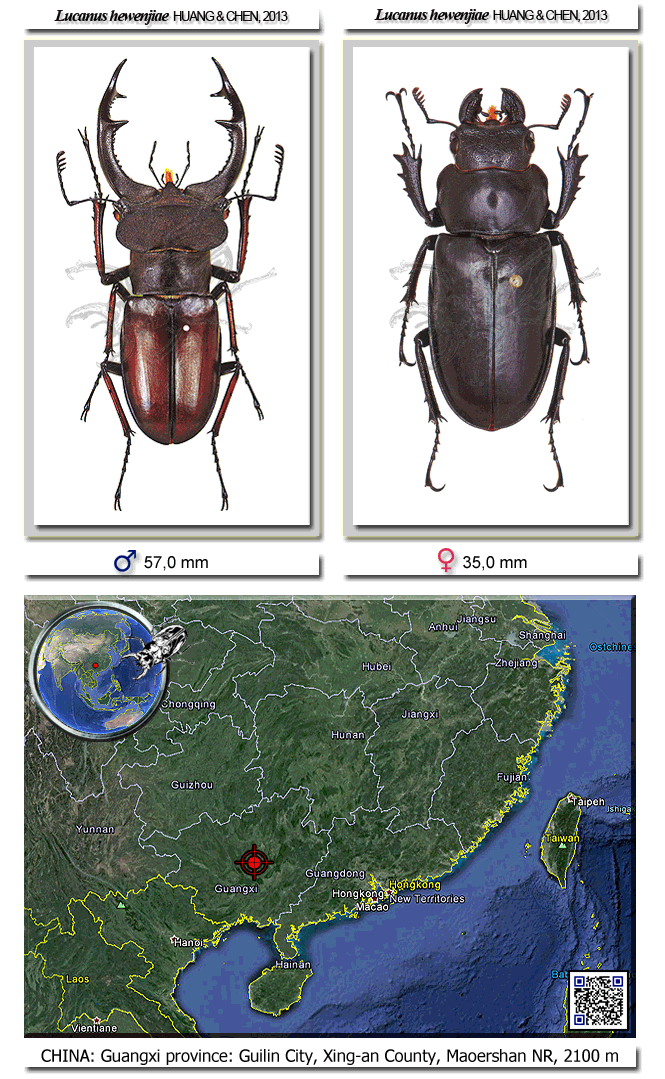 Lucanus hewenjiae HUANG & CHEN, 2013
Lucanus hewenjiae HUANG & CHEN, 2013
Type data. Holotype ♂:
CHINA: Guangxi province: Guilin City, Xing-an County, Maoershan Nature Reserve, ca. 2100 m; VII.2011, L. Tang & W.-J. He leg., deposited in Shanghai Normal University, Shanghai, China (SHNU).
Paratypes: CHINA: Guangxi province: 3 ♂♂ (SHNU, CCCC, CHH), same data as holotype; 1 ♂ (CCCC), same locality as holotype, 27. VI. 2003, H.-L. Shi leg.; 1 ♂ (CCCC), same locality as holotype, VII. 2012, W.-X. Bi leg.; 1 ♂, 1 ♀ (CHH, CCCC), same locality as holotype, VII. 2010 & 2011, anonymous students of Guangxi Normal University leg.; 1 ♂ (CCCC), same locality as holotype, 22. V. 2013, Y.-F. Hsu leg..
Etymology. This new species is named in honor of Ms. Wen-Jia He, Shanghai, who collected the holotype of this interesting species.
Diagnosis. This new species is very similar to L. deuveianus, L. brivioi, L. fairmairei and L. szetschuanicus, but can be distinguished from all of them by the fallowing combination of characters:
1) mandible of large male more evenly curved, not bent unevenly at subbasal parts as in L. deuveianus, L. brivoi and L. fairmairei;
2) lower or inner branch of apical fork of mandible in large males longer than in L. brivioi and L. deuveianus;
3) mandible of large males with continuous small teeth just inside of the major tooth, not smooth there as in L. szetschuanicus;
4) major tooth of the mandible in large males much shorter than in L. brivioi, L. deuveianus and L. fairmairei;
5) lateral carinae of head in large males broadly rounded, not produced laterally as in L. fairmairei;
6) pronotum of female widest at lateral angle, not at anterior part as in L. szetschuanicus and L. deuveianus;
7) canthus of female not extending beyond the eye laterally as in L. fairmairei;
8) inner branch of apical fork of female protibia a little curved at tip, not triangular as in L. fairmairei;
9) basal piece of aedeagus slenderer than in L. deuveianus, L. brivioi, L. fairmairei and L. szetschuanicus;
10) penis like in L. brivioi, markedly narrower than in L. deuveianus and L. fairmairei and longer than in L. szetschuanicus;
11) caudal ventral plate of basal piece with the pigmented part more deeply excavated in center than in L. brivioi;
12) spermathecal duct of female genitalia constantly much shorter than in L. deuveianus, L. fairmairei and L. szetschuanicus;
The small-sized males of L. hewenjiae are very similar to those of L. brivioi and L. deuveianus, but can be distinguished from them by having a straighter mandible with shorter major tooth. Thay are different from the same-sized males of L. fairmairei and L. szetschuanicus by having a straighter mandible.
Length of body including mandibles. males: 44-57 mm, females: 30-35 mm.
REFERENCE:
HUANG HAO & CHEN CHANG CHIN, 2013. Stag Beetles of China II. Taiwan.
(text: pages 33-34; photos: plate 8; all rights reserved to the authors)

